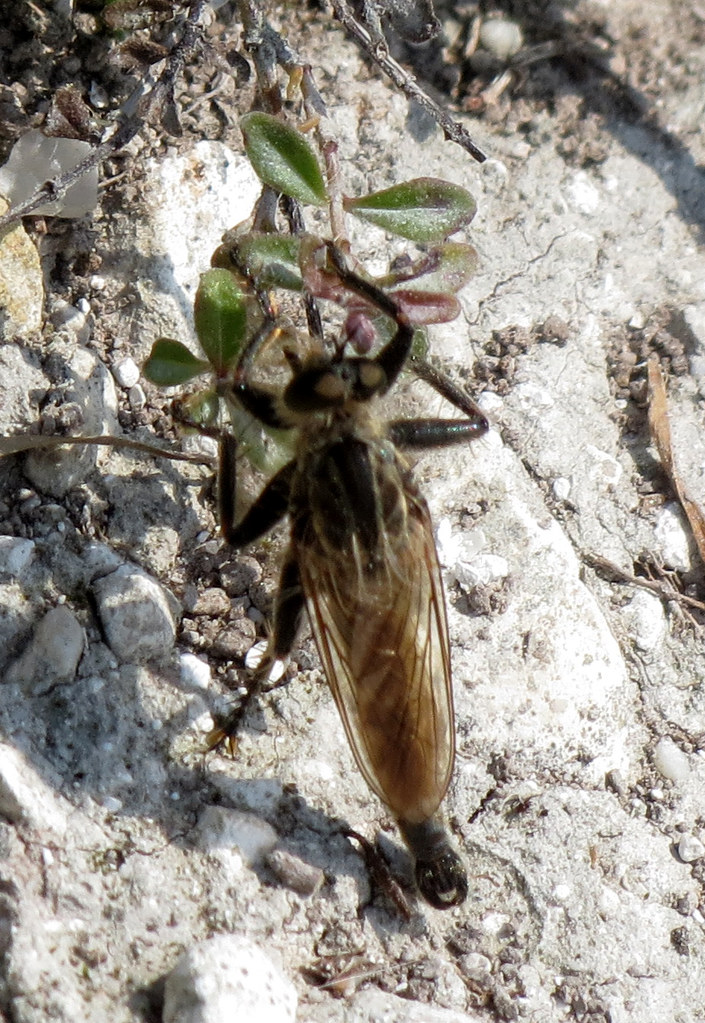Thread subject: Diptera.info :: Robber Fly from Sussex chalk downs, England
Posted by Perseus on 16-08-2013 23:18
#1

The usual specimens we get are the Hornet Robber Flies,
Asilus crabroniformis, so this one came as a surprise. Seen at the beginning of August 2013.
Location:
http://www.glaucu...l2013.html
Posted by ChrisR on 17-08-2013 08:34
#2
Could it just be a freshly emerged Asilus? Do you have more angles and can you give us an idea of their size, relative to the usual Asilus?
Posted by Perseus on 17-08-2013 09:57
#3
Thanks for you suggestion. I had it automatically down as Asilus until I saw the picture. And even then I was not sure until somebody else came up with the query from their own observations. Asilus is regularly seen at both sites as this one. But definitely smaller by 20% this one.
It is the only photograph. Instant reactions of point and shoot as it only settled on a chalky path for a second. Lucky to get it in the frame at all.
Edited by Perseus on 17-08-2013 10:04
Posted by Perseus on 17-08-2013 10:02
#4

One of the normal Asilus. They are great predators on butterflies. From local observations second aerial predator to the Southern Hawker. Hundreds of prey items in an acre at the moment.
I think this one shows the relative sizes.
Edited by Perseus on 17-08-2013 20:18
Posted by Perseus on 17-08-2013 10:10
#5
Addenda: behaviour and location was identical to Asilus. So were dates. But dates are still behind this year. Not three weeks like before the warm spell, but about a week behind for the butterflies.
Posted by Fred Fly on 17-08-2013 20:02
#6
Couldn't it be Machimus rusticus?
Posted by Quaedfliegh on 19-08-2013 22:22
#8
I think it is M rusticus but i should see a lateral image.
Edited by Quaedfliegh on 19-08-2013 23:15
Posted by Perseus on 19-08-2013 23:48
#9
https://www.facebook.com/photo.php?fbid=10201970770899524&set=gm.325800567555559&type=1&theater
Same location, same year, possibly the same species: https://www.facebook.com/photo.php?fbid=10201970770899524&set=gm.325800567555559&type=1&theater
Posted by Perseus on 19-08-2013 23:49
#10

Posted by Perseus on 20-08-2013 09:42
#11
The above picture (by Su Reed) was found in the same location several times, but this is the first photograph. I have only seen one.
Posted by Quaedfliegh on 21-08-2013 17:28
#12
This last pictures is a female Tolmerus (Machimus) atricapillus (could also be T. micans but that species has never been recorded in the UK). In the Netherlands Tolmerus atricapillus is called the "Common robberfly", together with Dysmachus trigonus by far the most widespread asilid. In NL it is rarer on chalk grasslands in the south. Very numerous on sandy soils. Machimus rusticus, on the other hand is only found on chalk grasslands in NL.
I am pretty sure this is M rusticus but based on looks, location and shape of genitalia. In the UK there is a look alike, M arthriticus. This species has usually more red on tibia, more slender male genitalia and prefers a sandy soil. To be sure the underside of the front femora should be visible, if there is only hair it is rusticus, if there is a row of bristles too then M arthriticus.
Edited by Quaedfliegh on 21-08-2013 17:30
Posted by Perseus on 02-12-2013 03:34
#13
Quaedfliegh wrote:
This last pictures is a female Tolmerus (Machimus) atricapillus (could also be T. micans but that species has never been recorded in the UK). In the Netherlands Tolmerus atricapillus is called the "Common robberfly", together with Dysmachus trigonus by far the most widespread asilid. In NL it is rarer on chalk grasslands in the south. Very numerous on sandy soils. Machimus rusticus, on the other hand is only found on chalk grasslands in NL.
I am pretty sure this is M rusticus but based on looks, location and shape of genitalia. In the UK there is a look alike, M arthriticus. This species has usually more red on tibia, more slender male genitalia and prefers a sandy soil. To be sure the underside of the front femora should be visible, if there is only hair it is rusticus, if there is a row of bristles too then M arthriticus.
Thanks for the last reply. I have independently IDed the last picture as
Machimus atricapillus Unsure now after a break. Linked in picture to this discussion. The first one was assumed to be the same species. It might not be though?
Edited by Perseus on 02-12-2013 03:36
Posted by Quaedfliegh on 04-12-2013 01:26
#14
No, last picture is not the same species as the one in the first picture. Asilidae might be a difficult lot but.... Last picture is Tolmerus (Machimus) atricapillus 99.9% : ) First picture is probably M. rusticus by default again.



